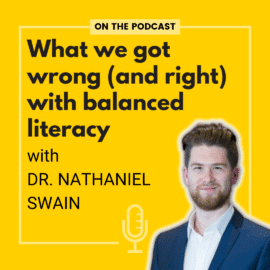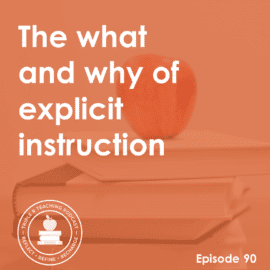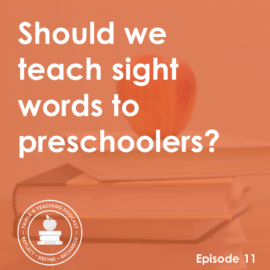
TRT Podcast #136: How to get more students to answer your questions
Are you tried of asking a question and seeing only a few hands go up? Here are ways to get everyone to respond!
Listen to the episode here
Full episode transcript
Let's talk about how to elicit more responses from our students. How can we get them to answer our questions more frequently? When students respond more frequently, they're more attentive and they're on task. They're also practicing the information. They're practicing retrieving it and pulling out of their long-term memory, and that increases the likelihood that they're going to remember it.
In order to do this, the number one thing is we have to kind of break a habit that many of us have had for years, possibly decades, and something we remember from our own school days. That habit is asking a question, waiting for a student to raise their hand, and then calling on that student.
Believe me, I understand what a HARD habit this is to break, but the problem with this is you're just calling on people who know the answer, who are the fastest, who like to participate, and we're not giving everyone a chance.
We can instead take advantage of choral responses. Research shows that asking for unison responses actually increases on-task behavior and academic learning.
To ask for a unison response, what you'll want to do is teach your students a cue that lets them know that you want everyone to answer. You could say something like, "Everyone?" and then you hold out your hand, and your hand held out means you're waiting for that answer.
For example, "How do we spell the sound /ch/ after a long vowel or a consonant? Everyone?"
Then I hold out my hand and they say, "C-H."
"How do we spell the sound /ch/ after a short vowel? Everyone?"
I put my hand out, and they say, "T-C-H."
If you have a problem with someone not participating, you could say, "Let's say that again. Everyone?" and just keep insisting that everyone participate, especially when you know that everyone knows the answer.
Something else you can do is have your students write the answer on an individual dry erase board and then flip it when you want to see the answer. In this way, you can very quickly see who knows the answer and who doesn't.
If getting together a class set of dry erase boards is a hardship for you, you could make homemade dry erase boards by putting a piece of white card stock inside of a clear page protector. Kids can write on those with dry erase markers, and they can erase with an old sock or a rag.
When the answer will be one of several options, or maybe just two options like true or false, you could have your students write the answers on index cards and then hold up the correct answer.
Recently, I gave a four hour presentation on the science of reading to an organization. What I did was go through what the research says, and doesn't say, about different elements of teaching reading. I had the teachers cut apart an index card and write a T on one side and an F on the other. When I read a statement, they had to hold up the T card if they thought it was true and F if they thought it was false.
This worked really well with adults too, and it certainly kept them engaged and required them to think a little bit about what we were doing. And then I could look at them quickly and see where misunderstandings were.
Something else you could do if you're doing yes or no, or true and false, is just have kids put their thumb up by their chest. That way it's not really obvious to all their classmates whether or not they know the answer. If it's true, they put a thumbs up. If it's false, they put a thumb down.
Another way to increase the amount of responses is to have your students work in pairs, and a lot of teachers give each person in the pair a name, like One and Two, Milk and Cookies, or Chips and Salsa. I tend to go with Ones and Twos.
What you would do is they would have a partner that they know is their partner, someone that sits near them probably. After you ask a question, you would say, "Ones, turn to your partner."
When they're working in pairs, you'll want to do a lot of practice with this. You'll want to teach them how to be effective listeners, like looking at their partner, leaning in, whispering the answer.
You can also give them sentence starters. If I've just finished reading a chapter in Charlotte's Web, I could say, "Twos, lean to your partner and finish this sentence. Wilbur was brave when he..." And of course, always require them to start with the sentence starter, "Wilbur was brave when he..." and then they finish it.
You can also use something called think-pair-share, which has been around for a long time. That's when you ask a question, let students think for a minute, and then talk to a partner.
Now this isn't to say that you should never call on individuals, because there are some questions that have multiple answers, or the answer depends on everyone's experience, so it's not going to work to do a choral response, but you can still hold everyone accountable.
One way to do this is to have students get in pairs, have them share their answer with their partner, and then randomly call on a student to tell you what his partner had to say.
I hope you'll start trying choral responses to get your students more actively involved and to answer more questions. It'll take a little bit of practice for you and your students to get used to this new way of answering questions, but I think you'll find that it gets everyone more involved.
You can find today's show notes at themeasuredmom.com/episode135. There I'll share a link to my favorite book about explicit instruction by Anita Archer and Charles Hughes where I learned more about using choral responses. I'll also send you to some videos on the Explicit Instruction website where you can see Dr. Anita Archer in action. She really does a great job of eliciting more responses from students.
We'll talk to you next time!
Sign up to receive email updates
Enter your name and email address below and I'll send you periodic updates about the podcast.
Explicit instruction resources
- Explicit Instruction, by Anita Archer & Charles Hughes
- Videos of explicit instruction, with Anita Archer
Looking for structured literacy resources?

Our membership has hundreds of printables for teaching phonics – not to mention decodable passages, complex texts, poems, plays, and more!







Leave a Comment